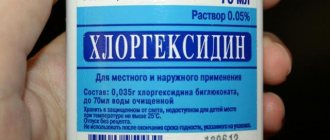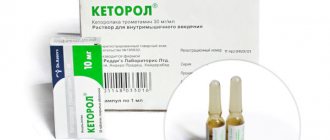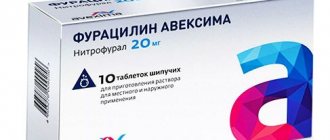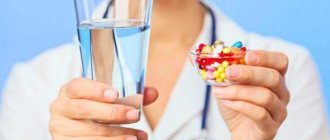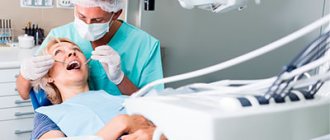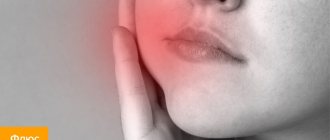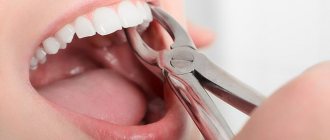A complete overview of the useful product: scope, rules of use and main indications
Even simple tooth extraction inevitably leads to tissue trauma. Therefore, after the procedure, it is very important to follow the doctor’s recommendations to prevent infection of the open wound, inflammation of surrounding tissues and the development of other complications. One of the main aspects of prevention during the rehabilitation period is maintaining hygiene with regular antiseptic treatment of the oral cavity. For this purpose, specialists usually prescribe antibacterial solutions for rinses and mouth baths, for example, Chlorhexidine. Further in the article, read about the indications for use of the product, its pros and cons, precautions, as well as how to properly rinse your mouth with Chlorhexidine after tooth extraction.
The use of Chlorhexidine for swelling of the gums
The drug is indicated for relieving inflammation of local gum swelling after implantation or tooth extraction. Its antimicrobial properties help avoid suppuration and infection of the wound. Helps reduce swelling and irritation of the mucous membrane.
On average, the course is 1 week. To perform oral baths, liquid is drawn into the mouth, held for 1-2 minutes and spit out. If the procedure is performed after brushing your teeth, you must thoroughly rinse off any remaining toothpaste. The components in its composition can sharply reduce the effectiveness of Chlorhexidine.
"Chlorhexidine" - what is this drug and when is it indicated for use?
We are talking about one of the most effective and at the same time financially affordable drugs with an antibacterial effect. This is a disinfectant solution, the action of which is aimed at combating pathogenic microflora - fungal or bacterial etiology. The use of the product in dentistry provides high-quality antiseptic treatment of the mucous membrane and teeth during or after treatment of pathological conditions, with cuts and trauma to oral tissues, after tooth extraction, including complex extraction of wisdom teeth, as well as after any other surgical interventions. The drug is indicated for use at any age, including children and women during pregnancy, but only as prescribed by a doctor.
The solution is a clear, almost odorless liquid. The drug is based on the active substance – chlorhexidine bigluconate. Chlorhexidine is available in different forms: spray, solution or vaginal suppositories. At the same time, the spray and solution are also used to disinfect skin and medical instruments. The active component is effective against most pathogenic microorganisms, various viruses and yeasts.
The drug is produced in various forms
How does chlorhexidine work?
When a person treats the oral cavity with chlorhexidine, the drug settles on the mucous membrane in the form of a thin film. It remains on the tissues of the oral cavity for several hours, continuing to protect them from the effects of pathogenic microorganisms.
This mechanism of operation ensures a high concentration of the drug on damaged tissues. This is what makes chlorhexidine digluconate one of the most effective drugs, and this means that this is exactly what to rinse your mouth with if your gums are inflamed.
This drug is also used for the following problems:
- gingivitis;
- periodontitis;
- stomatitis;
- in inflammatory processes after tooth extraction;
- with inflammatory processes of the hood located above the wisdom tooth;
- during disinfection treatment of dentures.
Action and effectiveness of the solution after tooth extraction
After removing a tooth from its socket, an open wound remains in the mouth, which quickly fills with blood. Next, a blood clot forms in it, which becomes a kind of protective barrier that prevents the penetration of bacteria and the spread of infection through injured tissue. When this clot does not fit too tightly to the socket, is damaged, falls out, or does not appear at all, the risk of developing serious complications - alveolitis, which can subsequently lead to osteomyelitis of the jaw and osteonecrosis, that is, gradual necrosis of bone structures, increases significantly.
The photo shows a blood clot after tooth extraction
The main reason for the development of this complication is insufficient oral hygiene during the rehabilitation period. Harmful microorganisms penetrate the alveoli and provoke inflammatory processes. To prevent this, after tooth extraction, the doctor prescribes oral baths using Chlorhexidine. The drug provides high-quality disinfection of all surfaces in the oral cavity, prevents the development and spread of pathological processes of an inflammatory nature.
What solution to use for rinsing the mouth after implantation
It is recommended to use an aqueous 0.05% solution. It is effective even with large blood clots after extraction and promotes rapid wound healing. Rinses are prescribed in courses as prescribed by the dentist. You cannot use the drug for longer than the recommended period due to the risk of severe irritation of the mucous membrane.
Smokers and people with diabetes can use alcohol-based Chlorhexidine rinses. This composition ensures high safety and stabilization of the drug. Local treatment with an alcohol-containing drug significantly reduces the formation of plaque in the oral cavity, especially after implantation.
What are the advantages and disadvantages?
The drug is widely used in dental practice, and there is a whole list of good reasons for this. Experts cite the following points as the main advantages of “Chlorhexidine” for mouth rinse:
- helps in the fight against pathogenic microflora,
- has a wide range of antibacterial action,
- is inexpensive - about 15 rubles per bottle,
- provides a long-lasting antimicrobial effect – up to 4 hours,
- approved for use by children, as well as women during pregnancy and breastfeeding - in a minimum concentration.
The drug can be used by pregnant women.
But despite such an impressive list of advantages, the antiseptic has some disadvantages. The liquid has a bitter taste, which in some cases makes it difficult to use and provokes vomiting. The solution may be ineffective against powerful viral attacks (with the exception of herpes). After a course of using the drug, teeth may acquire a grayish tint. You need to stop rinsing so that the enamel returns to its original appearance.
How to properly prepare a solution for rinsing and mouth baths
Now pharmacies sell solutions that are ready for use - in a concentration of 0.05%. It is recommended to use one tablespoon of the product to treat oral tissues.
There are also solutions on sale at a concentration of 0.20% - they must be diluted before use. To do this, take 2.5 ml of concentrate (the exact volume can be measured using a regular syringe) and dilute it in a liter of water. The substance should be thoroughly mixed. If a burning sensation occurs while rinsing, you need to add a little more water. It is important to follow the recommended proportions so as not to cause soft tissue burns.
The main points of rinsing
Chlorhexidine bigluconate is effective against bacteria that can cause diseases and inflammatory processes in the oral cavity, which means this medicine is exactly what you should use to rinse your mouth with when you have gum inflammation. The drug has no activity against viruses.
Important: chlorhexidine bigluconate can solve the problem only with an integrated approach to the problem of gum inflammation.
You should rinse your mouth with this drug, observing the following rules:
- Rinsing is carried out twice a day, at equal intervals.
- You should rinse 30 minutes after eating, after brushing your teeth.
- It is advisable to take the next meal after 2 hours or more. This will allow you to maintain the therapeutic effect for as long as possible.
- Rinse with chlorhexidine for at least one minute. It is this time that is necessary to create an active film, which is the basis of the operating mechanism of the drug.
- When treating gum inflammation, rinsing continues for 10 days.
You need to rinse according to the following scheme:
- prepare one tablespoon of chlorhexidine;
- take the liquid into your mouth and rinse your mouth for the prescribed time;
- when rinsing, you do not need to tilt your head back, unless such a recommendation was given by the attending physician;
- spit out the medicine completely.
The photos and videos in this article will help you understand the correct rinsing procedure.
Recommendations for the use of "Chlorhexidine" - instructions for use
Regarding how many times a day you can rinse your mouth with this product, you should immediately note that using it too often during the day risks causing irritation and even burns of the mucous membrane. If you overdo it with Chlorhexidine after tooth extraction, this can lead to the displacement of a blood clot and the development of related complications.
To ensure a therapeutic and prophylactic effect, it is enough to rinse your mouth twice a day - morning and evening. If bleeding gums occur, the frequency can be increased to three times a day, but no more. Rinsing the mouth should be carried out according to the following instructions:
- First, you should brush your teeth thoroughly,
- After about an hour, you need to rinse your mouth with boiled water at room temperature,
- Next, you should take a small amount of liquid into your mouth (about one tablespoon) and hold it a little on the side of the extracted tooth - 2-3 minutes,
- spit out the product and then do not rinse your mouth, eat or drink for at least an hour.
A tablespoon of product is enough for rinsing.
The duration of a standard preventive course is 1-2 weeks. When rinsing, it is important not to allow the product to enter the digestive tract, as this can cause irritation of the mucous membrane of the stomach and intestines. After using the product, it is not recommended to eat or drink for 1-1.5 hours, otherwise the effectiveness of the solution will decrease.
If you use the product for a long time, it can have the opposite effect - destroy beneficial flora and lead to the development of dysbacteriosis. This pathological condition is characterized by the appearance of bad breath, the formation of dense plaque on the mucous membrane and other symptoms. Most often, dysbiosis leads to the development of stomatitis - inflammation of the mucous membranes in the oral cavity.
How to do mouth baths correctly
At the beginning of the rehabilitation stage, it is difficult to perform hygiene procedures. Therefore, the patient is prescribed rinses with antiseptics. For the first few days, it is recommended to apply a bandage or cotton swab soaked in a 0.1% solution. Then proceed to direct rinsing, which must be done carefully .
Until the wound has completely healed, rinsing is replaced with oral baths.
«
You can use the drug up to 6 times a day, 10 ml. Rinsing takes 1-2 minutes. You cannot brush your teeth or eat food for half an hour after the procedure.
Rinsing is a good prevention of gum suppuration under the implant, eliminating the risk of bacteria entering the wound. To enhance the effect, during the first 2-3 days you can alternate with Betadine every other time.
Why you shouldn’t rinse your mouth after tooth extraction or how to do it correctly
We have found out how to properly dilute the solution and rinse your mouth with it, and now let’s move on to the question of whether it is possible to rinse the hole with it after tooth extraction. The thing is, after such a procedure, any antiseptic solutions can be used exclusively for oral baths. Rinsing and anything that can create a vacuum in the oral cavity is strictly contraindicated. Otherwise, the risk of damage to the blood clot in the socket will seriously increase, and this is fraught with the development of a whole series of complications.
“I always have chlorhexidine in my medicine cabinet - where would I be without it! By the way, it is better to keep it in the refrigerator. In my opinion, this is an excellent product and at the same time so cheap. I use it to treat my youngest son’s wounds if he gets scratched somewhere, and I rinse his mouth when his gums become inflamed...”
EkaterinaT., from correspondence on the forum www.32top.ru
It is important to follow the instructions for use.
To carry out antiseptic treatment, just take a small amount of the product into your mouth and hold it on the side of the causative area. The liquid should then be spat out. There is no need to rinse your mouth with water after the procedure.
Is it possible to rinse your mouth with Chlorhexidine?
Rinsing the mouth with this drug helps quickly eliminate inflammation and swelling, and has a regenerating effect on damaged tissue.
It is allowed to use Chlorhexidine for a number of diseases:
- Inflammation of the gums. Helps quickly eliminate unwanted symptoms and minimizes the risk of periodontal disease.
- Stomatitis. It is used for ulcerative and aphthous forms caused by the herpes virus.
- Throat diseases. Used to eliminate negative symptoms of pharyngitis, sore throat and laryngitis.
Chlorhexidine is used for stomatitis
In dentistry, it is recommended to use after tooth extraction, if there is a risk of wound infection, or for toothache. Chlorhexidine also prevents plaque on tooth enamel and eliminates bad breath.
The drug promotes the rapid elimination of biofilm at the site of the inflammatory process - this makes harmful microorganisms vulnerable to the action of the antibiotic.
Contraindications and side effects
The drug has virtually no contraindications. The only exceptions are various groups of dermatitis. However, in rare cases, intolerance to the active substance and allergic reactions are detected - in less than 1%.
As for adverse reactions, they also appear only in extremely rare cases. Sometimes there is drying of the mucous membranes, slight plucking, burning and itching. If these manifestations are of moderate intensity, you can try adding a little more water to the solution. It should be noted that most patients tolerate Chlorhexidine well.
During pregnancy and breastfeeding
"Chlorhexidine" is indicated for use by women during pregnancy and breastfeeding, but only if the patient does not have open wounds or cuts in her mouth. The drug has a superficial effect and is not absorbed into the blood or breast milk.
When breastfeeding, the drug can also be used
For small patients, the preferred form is a spray - it does not require rinsing skills to use. With its help, you can easily treat any areas of the oral mucosa. However, Chlorhexidine should not be used on children under 3 years of age, in particular for irrigating the tonsils. In both cases, the maximum permissible course duration should not exceed 10 days, and the use of the drug must be agreed with a doctor.
Why do you need Chlorhexidine: properties and action
After a tooth is removed, an open wound remains in the gum and fills with blood. A blood clot forms in the hole, protecting the open area of the periosteum from the penetration of pathogenic bacteria and microbes. If the clot does not adhere tightly to the socket or is accidentally damaged during eating, the risk of infection of the bone tissue and the development of osteomyelitis of the jaw increases - a purulent-inflammatory pathology, which, if not treated in a timely manner, can lead to the death of bone structures (osteonecrosis).
And this is how a blood clot may look in real life - it is very important not to wash it out when rinsing your mouth
To avoid damaging the clot, the following recommendations must be followed:
- in the first 1-2 days after removal, you should not drink through a straw, spit saliva, or perform other actions that create a vacuum in the mouth;
- You can chew on the side on which the removal took place 72 hours after surgery;
- You need to rinse your mouth carefully, trying not to make too active movements;
- Do not touch the clot with your tongue or try to remove it from the hole.
Another common complication after tooth extraction is alveolitis. This is a disease in which inflammation of the socket occurs. The pathology is accompanied by fever, severe pain, which can radiate to the ear, eye area, jaw and cervical and submandibular lymph nodes. The gums at the extraction site swell, and severe swelling and redness appear.
- How to rinse your mouth with Chlorhexidine for gum inflammation
Development of alveolitis in the socket after tooth extraction
The main cause of alveolitis is non-compliance with the hygiene regime and an increase in the number of pathogenic flora in the oral cavity. Pathogenic microorganisms entering the alveoli cause inflammation of soft tissues and the development of a pathological process. To prevent alveolitis and other possible complications, the patient is prescribed local treatment of the oral cavity with antiseptic solutions, one of which is Chlorhexidine. The use of this drug ensures disinfection of the mucous membranes and hard tissues of the tooth and prevents the development of infectious and inflammatory processes.
Tooth extraction is a full-fledged surgical operation.
Video - “Chlorhexidine”: application and effectiveness
What can be replaced - alternative options
"Chlogexidine" belongs to the class of inexpensive drugs, but it may not always be on hand or in the assortment of the pharmacy. Among analogues with identical active ingredients in their composition, experts identify the following medicines:
- “Instillagel” - along with chlorhexidine digluconate, the composition includes lidocaine, hydrochloride and auxiliary components. It has a pronounced bactericidal effect and gives an analgesic effect; it is often used as a local anesthetic during endoscopic examinations,
- "Baktosin" - the composition also contains a solution of cetrimide. The drug is available in liquid form and is prescribed as part of the treatment of purulent skin infections, as well as pathologies of the oral cavity and bacterial urological diseases,
- “Citeal” also contains chlorocresol and hexamidine diisothionate. Used for antiseptic treatment of skin and mucous membranes for bacterial and fungal infections.
There are other solutions, but they will already contain another active component. One of the most popular drugs belonging to this category is the drug Miramistin.
"Chlorhexidine" or "Miramistin" - what to choose
Another popular means for antiseptic treatment of oral tissues is the Miramistin solution. It is based on another active component - benzyldimethyl ammonium chloride monohydrate, but the essence of the action of the product and the degree of its effectiveness are approximately identical. The drug is also prescribed for the prevention and control of viral, bacterial and fungal infections.
Which drug is better to choose?
When answering the question of what to choose: “Miramistin” or “Chlorhexidine”, it is necessary to explain that both products are characterized by a similar effect and scope of application, but the latter has existed for a long time and during this time has managed to prove itself well. On the other hand, Miramistin is a relatively new remedy, no less effective and safe. If we talk about the differences between drugs from each other, then we can highlight only a few nuances:
- After shaking the bottle, Miramistin forms a dense foam that does not settle for a long time. In the case of Chlorhexidine, the opposite is true - the foam is liquid and settles quickly,
- "Chlorhexidine" is ideal for external use, but if it comes into contact with the mucous membrane, it can cause a noticeable burning sensation. "Miramistin" does not give such a reaction,
- Too long or frequent use of Chlorhexidine can lead to a change in the color of the enamel, while its competitor acts more gently and does not affect the appearance of the teeth.
When choosing the most suitable product for your specific case, it is better to trust an experienced specialist. Only a doctor, based on the individual characteristics of your particular clinical picture, will be able to choose the most effective drug.
Use of Chlorhexidine in dentistry
Upon contact with the mucous membrane, it forms a thin protective film. The effect lasts after the procedure for 24 hours.
Shown:
- with gingivitis;
- in case of development of periodontitis;
- against the background of treatment of stomatitis;
- in case of inflammation of the socket after tooth extraction;
- for inflammation caused by semi-impacted wisdom teeth;
- for disinfection of removable dentures;
- for root canal treatment;
- after installation of dental implants.
An alcohol-based chlorhexidine is used to treat the hands of a dental surgeon.
The antiseptic enhances the effect of surface anesthesia, therefore it is often prescribed together with Lidocaine. This reduces the number of bacteria at the injection site. Able to fight pathogenic microorganisms after removing stone and plaque.

